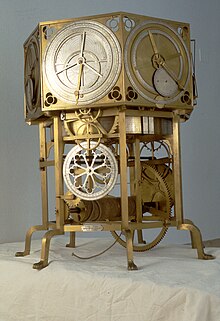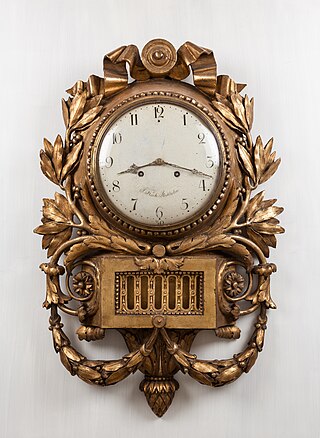
A clock or chronometer is a device that measures and displays time. The clock is one of the oldest human inventions, meeting the need to measure intervals of time shorter than the natural units such as the day, the lunar month, and the year. Devices operating on several physical processes have been used over the millennia.

An orrery is a mechanical model of the Solar System that illustrates or predicts the relative positions and motions of the planets and moons, usually according to the heliocentric model. It may also represent the relative sizes of these bodies; however, since accurate scaling is often not practical due to the actual large ratio differences, a subdued approximation may be used instead. Though the Greeks had working planetaria, the first orrery that was a planetarium of the modern era was produced in 1713, and one was presented to Charles Boyle, 4th Earl of Orrery – hence the name. They are typically driven by a clockwork mechanism with a globe representing the Sun at the centre, and with a planet at the end of each of the arms.
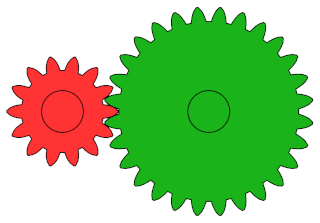
A gear is a rotating circular machine part having cut teeth or, in the case of a cogwheel or gearwheel, inserted teeth, which mesh with another (compatible) toothed part to transmit rotational power. While doing so, they can change the torque and rotational speed being transmitted and also change the rotational axis of the power being transmitted. The teeth on the two meshing gears all have the same shape.

The Antikythera mechanism is an Ancient Greek hand-powered orrery, described as the oldest known example of an analogue computer used to predict astronomical positions and eclipses decades in advance. It could also be used to track the four-year cycle of athletic games similar to an Olympiad, the cycle of the ancient Olympic Games.

A Differential is a mechanical device that allows wheels to rotate at different speeds while receiving equal torque. It's crucial for motor vehicles to navigate corners smoothly, as the outer wheel travels a greater distance than the inner one. Without a differential, the vehicle's wheels could slip, or the drive axle could snap.

Wilhelm Schickard was a German professor of Hebrew and astronomy who became famous in the second part of the 20th century after Franz Hammer, a biographer of Johannes Kepler, claimed that the drawings of a calculating clock, predating the public release of Pascal's calculator by twenty years, had been discovered in two unknown letters written by Schickard to Johannes Kepler in 1623 and 1624.
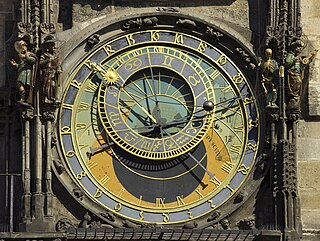
An astronomical clock, horologium, or orloj is a clock with special mechanisms and dials to display astronomical information, such as the relative positions of the Sun, Moon, zodiacal constellations, and sometimes major planets.
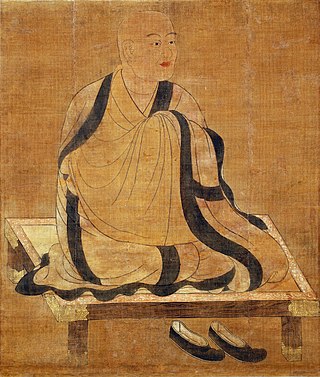
Yi Xing, born Zhang Sui, was a Chinese astronomer, Buddhist monk, inventor, mathematician, mechanical engineer, and philosopher during the Tang dynasty. His astronomical celestial globe featured a liquid-driven escapement, the first in a long tradition of Chinese astronomical clockworks.

An astrarium, also called a planetarium, is a medieval astronomical clock made in the 14th century by Italian engineer and astronomer Giovanni Dondi dell'Orologio. The Astrarium was modeled after the solar system and, in addition to counting time and representing calendar dates and holidays, showed how the planets moved around the celestial sphere in one timepiece. This was its main task, in comparison with the astronomical clock, the main task of which is the actual reading of time. A complex mechanism, it combined the functions of a modern planetarium, clock, and calendar into a singular constructive device. Devices that perform this function were known to have been created prior to the design of Dondi, though relatively little is known about them. It is occasionally erroneously claimed by the details of some sources that the Astrarium was the first mechanical device showing the movements of the planets.

An equatorium is an astronomical calculating instrument. It can be used for finding the positions of the Moon, Sun, and planets without arithmetic operations, using a geometrical model to represent the position of a given celestial body.
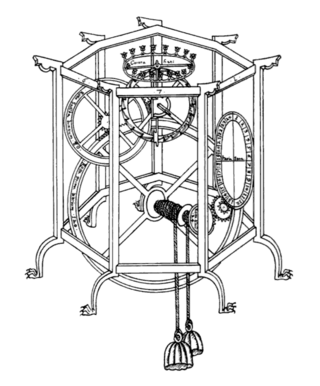
Giovanni Dondi dall'Orologio, also known as Giovanni de' Dondi, was an Italian physician, astronomer and mechanical engineer in Padua, now in Italy.

The York Minster astronomical clock is a memorial to the airmen operating from bases in Yorkshire, Durham, and Northumberland who were killed in action during World War II, designed by R. Atkinson, and installed in York Minster in 1955.

In mechanical engineering, backlash, sometimes called lash, play, or slop, is a clearance or lost motion in a mechanism caused by gaps between the parts. It can be defined as "the maximum distance or angle through which any part of a mechanical system may be moved in one direction without applying appreciable force or motion to the next part in mechanical sequence."p. 1-8 An example, in the context of gears and gear trains, is the amount of clearance between mated gear teeth. It can be seen when the direction of movement is reversed and the slack or lost motion is taken up before the reversal of motion is complete. It can be heard from the railway couplings when a train reverses direction. Another example is in a valve train with mechanical tappets, where a certain range of lash is necessary for the valves to work properly.

A mechanical watch is a watch that uses a clockwork mechanism to measure the passage of time, as opposed to quartz watches which function using the vibration modes of a piezoelectric quartz tuning fork, or radio watches, which are quartz watches synchronized to an atomic clock via radio waves. A mechanical watch is driven by a mainspring which must be wound either periodically by hand or via a self-winding mechanism. Its force is transmitted through a series of gears to power the balance wheel, a weighted wheel which oscillates back and forth at a constant rate. A device called an escapement releases the watch's wheels to move forward a small amount with each swing of the balance wheel, moving the watch's hands forward at a constant rate. The escapement is what makes the 'ticking' sound which is heard in an operating mechanical watch. Mechanical watches evolved in Europe in the 17th century from spring powered clocks, which appeared in the 15th century.

A spiral bevel gear is a bevel gear with helical teeth. The main application of this is in a vehicle differential, where the direction of drive from the drive shaft must be turned 90 degrees to drive the wheels. The helical design produces less vibration and noise than conventional straight-cut or spur-cut gear with straight teeth.
In horology, a wheel train is the gear train of a mechanical watch or clock. Although the term is used for other types of gear trains, the long history of mechanical timepieces has created a traditional terminology for their gear trains which is not used in other applications of gears.
The échappement naturel was the invention of Abraham-Louis Breguet, one of the most eminent watchmakers of all time. Following the introduction of the detent chronometer escapement with a temperature compensated balance, very close rates could be achieved in marine chronometers and to a lesser degree in pocket chronometers. This achievement was due, other things being equal, to the minimal interference with the balance during unlocking and impulse. A further key advantage of this escapement was that there was no need for oil on the escapement's working surfaces and hence no deterioration in the friction between the working surfaces as the oil aged. A drawback was that the detent escapement as it was used in pocket chronometers was prone to stopping as a result of motion. Most escapements are capable of being stopped by a sudden movement but the detent escapement gives an impulse to the balance only when it is moving in one direction. The escapement is therefore not self-starting. The lever escapement, as used in most modern mechanical watches, avoided this problem. In common with most other escapements it gave an impulse to the balance in both directions of the balance swing. This creates another problem in doing so because the introduction of a lever between the balance and the final (escape) wheel of the escapement requires lubrication on the acting surfaces.
Jacopo Dondi dall'Orologio (1290–1359), also known as Jacopo de' Dondi, was a doctor, astronomer and clock-maker active in Padua, Italy. He is remembered today as a pioneer in the art of clock design and construction. He was the father of Giovanni Dondi dall'Orologio. Jacopo Dondi wrote on a number of subjects, including surgery, pharmacology, astrology and natural science.

A computus clock is a clock equipped with a mechanism that automatically calculates and displays, or helps determine, the date of Easter. A computus watch carries out the same function.

The astronomical clock of St. Nicholas Church, Stralsund is a 14th century monumental astrolabe clock. It was probably damaged in the 16th century, and has not worked since then. It is the only clock of its kind to have been preserved almost entirely in its original condition. The clockwork and the indications have not been restored.



